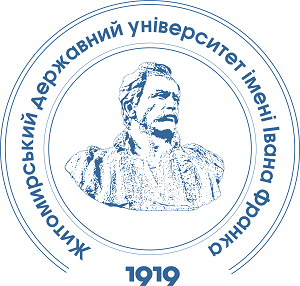PHYTOPLANKTON AS AN INDICATOR OF THE STATE OF THE WATER ECOSYSTEM OF A SMALL RESERVOIR
DOI:
https://doi.org/10.32782/naturaljournal.11.2025.10Keywords:
phytoplankton, water quality, Zhytomyr Reservoir, primary products, saprobityAbstract
The paper discusses some topical issues of the possibility of using phytoplankton to assess the water quality of small reservoirs using the example of Zhytomyrsky according to the results of research in 2023–2024. and previously published author’s data for 2004–2007 and 2008–2017.It was established that after cleaning the river bed Teteriv in 2022 in the Zhytomyr Reservoir, planktonic-benthic (37.0% of the number of indicator species) and planktonic (36.6%) forms of algae prevail. In terms of temperature limitation, eurythermic algae and forms that are limited to a moderate temperature regime, as well as thermophilic algae species (47.2%, 27.3% and 18.6%, respectively) have an advantage. The increase in the share of thermophilic forms over the last decade is probably the result of climate change. In relation to algae to the conditions of rheophilicity and saturation of water with oxygen, indifferents prevail (67.3%). Among the indicators of haloness, oligohalob-indifferents have a significant advantage – 70.2%, in relation to pH – indifferents (46.8%) and alkaliphiles (37.9%).The analysis of the level of organic pollution according to the Watanabe system showed the dominance of Eurysaprobes (63.4%) and saproxenes (25.7%). Based on saprobiological indicators of algae indicators of various types of pollutants, the priority of class II indicators of water quality was established (53.0%), while class III indicators were also statistically significant (37.8%).According to hydrochemical, hydrophysical and hydrobiological parameters (biomass, photosynthesis intensity, production-destruction coefficient), the Zhytomyr Reservoir mostly corresponds to the II–III class of water quality.A tendency to balance production and destruction processes (A/R=1.22±0.08) in 2023–2024 was established. after carrying out works on cleaning the bed of the Teteriv River and draining water from the lower basin of the reservoir due to the removal of an excess of dead autochthonous organic matter and pollutants in the bottom complex compounds.In general, during 2023–2024 in the water column of the Zhytomyr Reservoir, 173 species of algae, represented by 181 intraspecific taxa, including those containing the nomenclatural type of the species, from 8 divisions were found.
References
Афанасьєв С.О., Бабчук В.С., Бонь О.В., Васильєв С.В. та ін. Терміни та визначення водних Директив Європейського Союзу. Київ : Інтерсервіс, 2015. 32 с.
Васенко О.Г., Верніченко Г.А. Комплексне планування та управління водними ресурсами. Київ : Ін-т географії НАН України, 2001. 367 с.
Водна Рамкова Директива ЄС 2000/60/ЄС. Основні терміни та їх визначення. Київ : Твій формат, 2006. 240 с.
Методи гідроекологічних досліджень поверхневих вод / за ред. В.Д. Романенка. Київ : ЛОГОС, 2006. 408 с.
Мокрицький Г.П. Водопровід Житомира. Житомир : Волинь, 1999. 96 с.
Проєкт Стратегії сталого розвитку України до 2030 року від 07.07.2018 р. № 9015 [Електронний ресурс]. URL: UNDP_Strategy_v06-optimized.pdf (дата звернення 29.12.2024)
Сталий розвиток [Електронний ресурс]. URL: https://uk.wikipedia.org/wiki/.2016 (дата звернення 14.01.2025).
Barynova S.S., Medvedeva L.A., Anisymova O.V. Biodiversity of algae-indicators of the environment. Tel Aviv : Piles Studio, 2006. 498 c.
Cupertino A., Gücker B., Rückert G., Figueredo C. C. Phytoplankton assemblage composition as an environmental indicator in routine lentic monitoring: taxonomic versus functional groups. Ecological Indicators. 2019. № 101. Р. 522–532. https://doi.org/10.1016/j.ecolind.2019.01.054.
Guiry M.D., Guiry G.M. AlgaeBase. World-wide electronic publication, National University of Ireland, Galway, 2020 [Електронний ресурс] URL: http://www.algaebase.org (дата звернення 30.03.2024).
Ignatiades L. Taxonomic Diversity, Size-Functional Diversity, and Species Dominance Interrelations in Phytoplankton Communities: a Critical Analysis of Data Interpretation. Mar. Biodivers. 2020. № 50 (4). Р. 1–9. https://doi.org/10.1007/s12526-020-01086-4.
Shelyuk Yu.S., Shcherbak V.I. Phytoplankton Structural and Functional Indices in the Rivers of the Pripyat’ and Teterev Basins. Hydrobiol. Jornal. 2018. Vol. 54. № 3. P. 10–23. https://doi.org/10.1615/HydrobJ.v54.i3.
Shelyuk Yu.S. Regularities of primary production formation in river ecosystems (the basins of the Pripyat’ and Teterev Rivers, Ukraine). Hydrobiol. Jornal. 2019. Vol. 55. № 4. P. 38–54. https://doi.org/10.1615/HydrobJ.v55.i4.40.
Shelyuk Yu.S. Peculiarities of Phytoplankton Formation and Functioning in Small Water Reservoirs. International Journal on Algae. 2024. № 26 (3). Р. 273–284. https://doi.org/10.1615/InterJAlgae.v26.i3.50.
Tsarenko P.M., Wasser S.P., Nevo E. Algae of Ukraine: diversity, nomenclature, taxonomy, ecology and geography. Cyanoprocaryota, Euglenophyta, Chrysophyta, Xanthophyta, Raphidophyta, Phaeophyta, Dinophyta, Cryptophyta, Glaucocystophyta, and Rhodophyta. Eds. Ruggell : Ganter Verlag, 2006. Vol. 1. 713 p.
Tsarenko P.M., Wasser S.P., Nevo E. Algae of Ukraine: diversity, nomenclature, taxonomy, ecology and geography. Bacillariophyta. Eds. Ruggell : Ganter Verlag, 2009. Vol. 2. 413 p.
Tsarenko P.M., Wasser S.P., Nevo E. Algаe of Ukraine: diversity, nomenclature, taxonomy, ecology and geography. Chlorophyta. Eds. Ruggell : Ganter Verlag, 2011. Vol. 3. 511 p.






